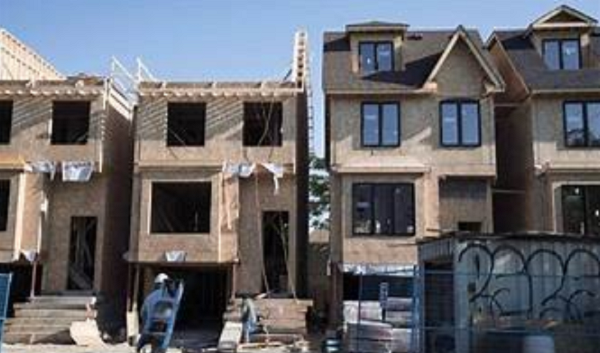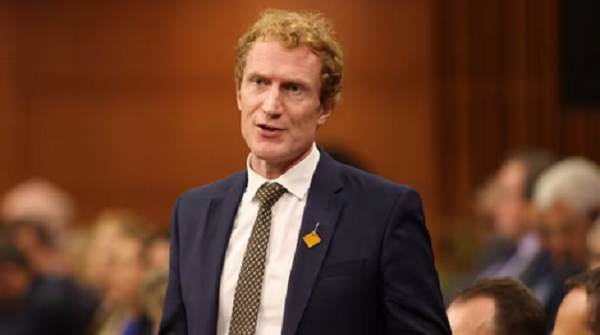A group planning to convert Toronto’s vacant office place into residential
A Canadian think-tank has a plan to keep young people from fleeing urban centres in search of more affordable accommodations.
As part of its Toboggan Flats project, Youthful Cities is working on a plan to convert vacant office spaces in Canada’s urban centres into residential co-living developments for young people struggling to pay rent in the country’s most expensive cities.
“Downtowns are starting to hollow out because people aren’t coming back to work,” Robert Barnard, co-founder of Youthful Cities, told CP24.com. “We’ve got these vacant office spaces that really could be housing.”
Barnard said the current state of Toronto’s housing market means it is nearly impossible for young people to afford to live downtown.
“Years ago, we built condos for young people to get downtown and with the intention they’re going to buy those condos. Now, young people can’t even afford to rent the condos that were built for the last generation of young people,” he said. “So the challenges are mounting.”
He said while cities around the world have begun to build co-living spaces for young adults, it is a relatively new concept in Canada.
“We’ve got students in residences. We’ve got seniors in seniors’ homes. We’ve got people sharing homes and sharing bathrooms and kitchens and laundry all the time. So it’s all around us,” Barnard said.
“This conversion of office space to co-living is kind of the ingenuity that Toboggan Flats is bringing and it’s been done in other places around the world, particularly in Paris, France, but it’s the first time in Canada and we’re excited to be doing it.”
Barnard said while converting office spaces into residential units can be costly, co-living models are more cost-effective and can be constructed more quickly.
“When you create a condo or an apartment, you have to put plumbing into each of those rooms and that’s extremely expensive and time consuming… That means that conversions have trouble creating affordable housing, which is what we’re focused on at Toboggan Flats,” he said.
“If governments want to build housing downtown, this is one of the best ways they can do it and it’s cost effective and it’s really nicely set up for those young workers to also help boost that local economy.”
He said the cost to rent a unit at a Toboggan Flats buildings would run about $1,200 a month, inclusive of utilities. That would provide a young tenant with a private, furnished, 175-square foot room with a shared bathroom, kitchen, and laundry facilities.
Depending on the configuration of the office building, Barnard said some co-living spaces could include gyms or rooftop patios. Things like cleaning services or fitness classes could also be built into the price, he said.
“Our goal is 100 per cent of these spaces would be affordable housing,” he said.
He noted that the average person ages 25 to 34 in Canada makes just over $50,000 a year.
“If we look at 30 per cent of your income, which is what people say is what you should spend on housing… that’s 1,250 a month,” he said. “A one-bedroom in Toronto downtown is over 2,500 a month.”
He said the think-tank recently did a study assessing demand for this type of living arrangement in Canada and found that about 30 per cent of respondents said they would be very interested in residing in a co-living space in a converted office building.
“It has tons of interest,” he said.
He added there are many social benefits to residing in co-living spaces.
“It’s actually building a community within those buildings. So it’s a great support network and young people these days in Canada are the most isolated group in society,” Barnard said. “So we want to create a solution for that too.”
He said while no projects have been completed to date, three buildings are under assessment in Toronto, along with two in Hamilton and others in Calgary and Ottawa.
The goal for the first phase of the project is to complete about 2,000 units across Canada, with some of those units up and running in 2025.
Barnard added that while they initially plan to target whole buildings for conversion, there is the possibility to convert certain floors of buildings, while other floors continue to operate as offices.
Office vacancy rate in Toronto remains high
Discussions around office conversions in Toronto have ramped up in recent years following an uptick in office vacancies in the downtown core. The City of Toronto is also now studying the possibility of allowing some office buildings to be converted into residential units in the wake of a housing affordability crisis.
According to a recent report published by real estate consultant CBRE(opens in a new tab), Toronto’s downtown office vacancy rate hit 18.1 per cent in the first quarter of 2024, the highest level since the 1990s.
Office vacancies skyrocketed during the COVID-19 pandemic as remote work became the norm for many office workers.
While there has been a significant shift in workers returning to offices downtown post-pandemic, office buildings have not fully recovered as hybrid work models remain in place.
But stubbornly high office vacancies in Toronto’s downtown core may not be cause for panic as experts say they are optimistic that the sector will rebound, albeit slowly.
“I’m actually kind of bullish on Toronto… The office situation in Toronto is much better than it is in a lot of North America,” Karen Chapple, the director of the School of Cities with the University of Toronto, told CP24.com.
“For instance, even if we’re approaching a 20 per cent vacancy rate in downtown Toronto, we have a situation in downtown San Francisco where there’s a 36 per cent vacancy rate.”
She said while office space in newer developments, such as The Well, are seeing remarkably low vacancy rates, some older office spaces are struggling to find tenants.
The older office buildings that have been successful in securing tenants, she said, are typically attracting more traditional businesses, like dental offices, where remote or hybrid work is not feasible.
“If you look in the big picture, if you look at office booms and busts over the last century and there’s been many of them, this is not as extreme as some of the ones we’ve had. It’s certainly nothing like what we’re seeing in some of the office markets south of the border,” Chapple said.
“I think we’re in pretty good shape but change is slow and we’re going to have to be very patient.”
Adam Jacobs, the head of research for Colliers Canada, an investment management company, said it is likely too early to begin thinking about widespread conversions at this point.
“I think we are going to see some more stability probably within the next year,” he said.
“There is no way the next five years are going to be this bad in terms of inflation, interest rates, work from home, new development,” he said.
He noted that it would likely take a “longer, deeper stretch of vacancy,” such as the one seen in Calgary, in order to begin a shifting toward converting these spaces for other uses.
“You’re not seeing the wrecking balls downtown yet,” he added.
Some offices ‘ripe’ for conversion
The city currently requires developers to replace any office space that is lost but that policy is currently under review as part of its Office Space Needs Study.
“The city has in some ways been very cautious… and it should be cautious about that because you don’t want to undermine your economy in the long run,” Chapple said.
But she said there are a small number of office buildings in the downtown core that are “ripe for turnover.”
Chapple called the Toboggan Flats project “very exciting work.”
“I think they’re onto something with the market there, that you have the folks priced out of the housing market,” she said.
“They just want to live in downtown Toronto for four or five years and then they’ll move out to the suburbs and you can catch them at this time of their life and a co-housing situation with a shared bath and kitchen is actually perfect for them.”
Barnard said getting projects cleared for development in Toronto provides an added hurdle for Toboggan Flats given the city’s policies around protecting office space.
“That’s a unique challenge in Toronto. We don’t have that challenge in Hamilton, Ottawa, Calgary and other cities. So that might mean it moves faster (in other cities),” he said.
“It looks like there’s a positive outcome on that coming up… it would make our lives a little bit easier if it gets resolved sooner. So we’re hopeful.”
This article was first reported by CP24













